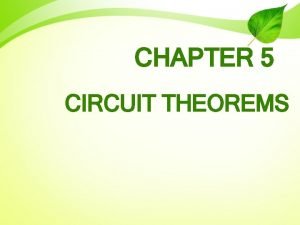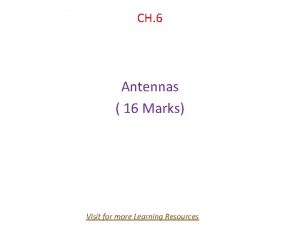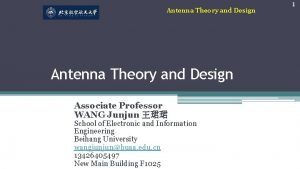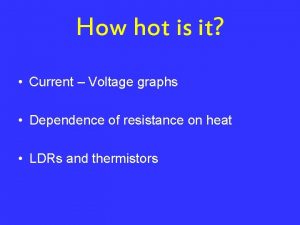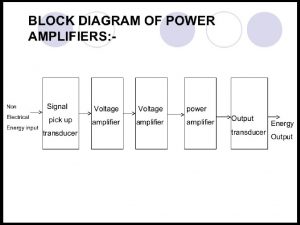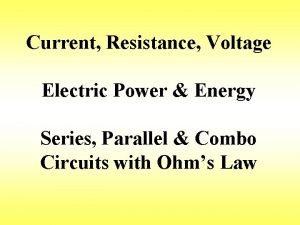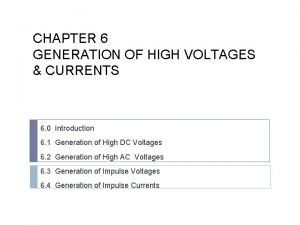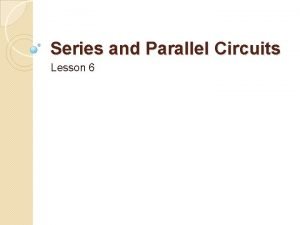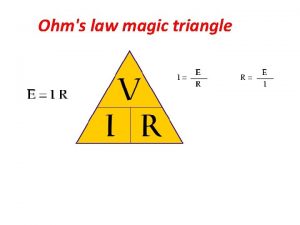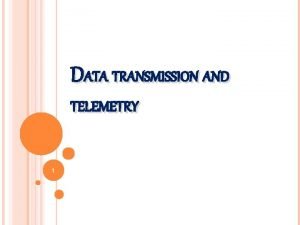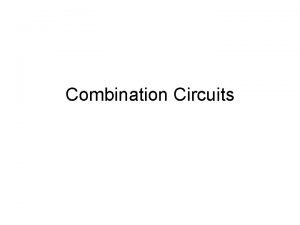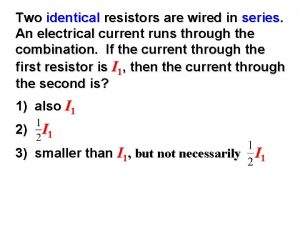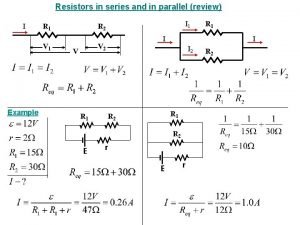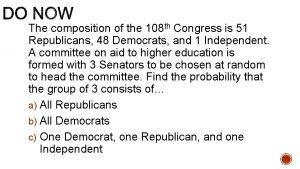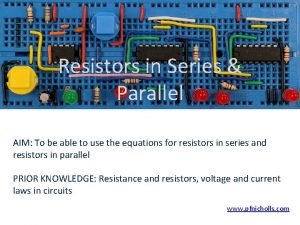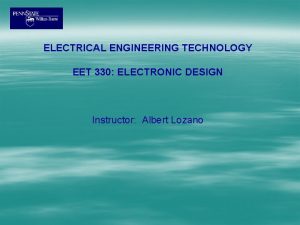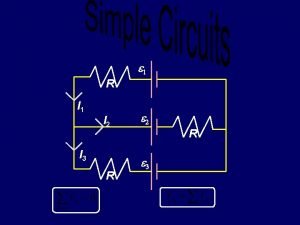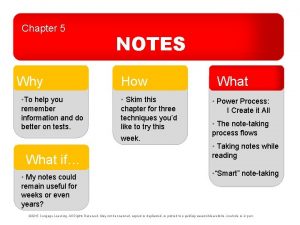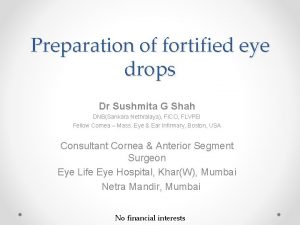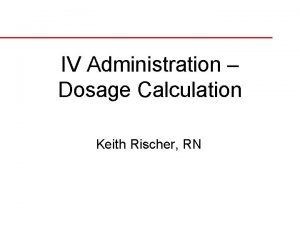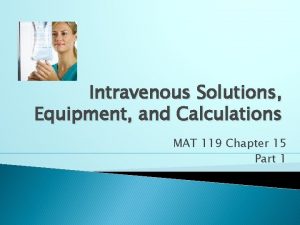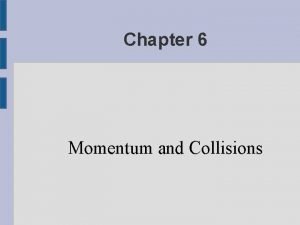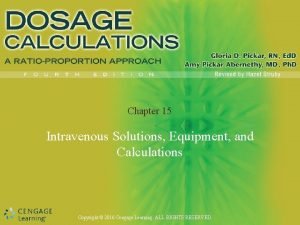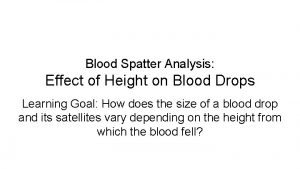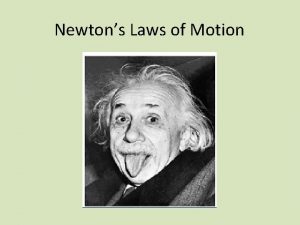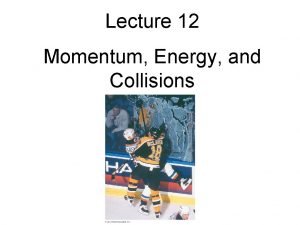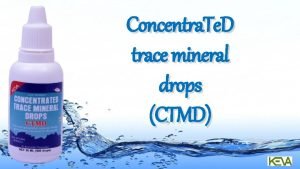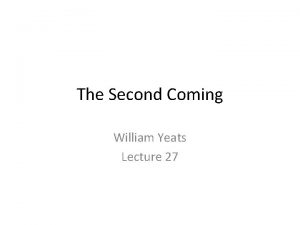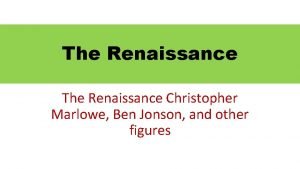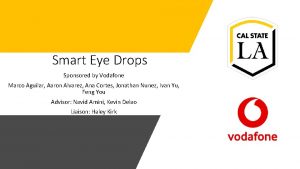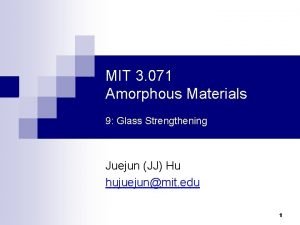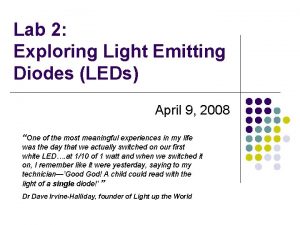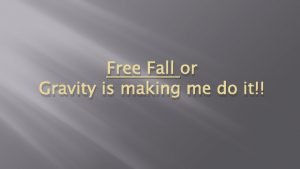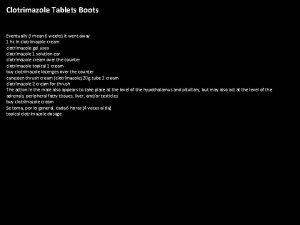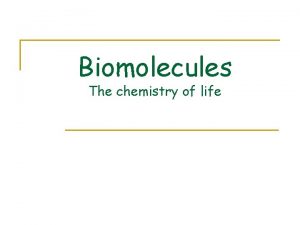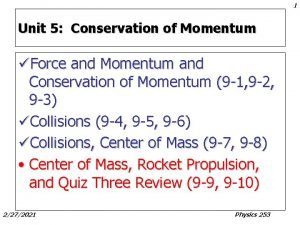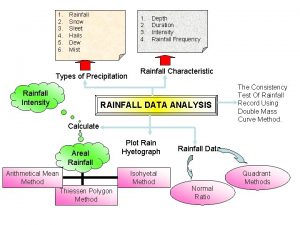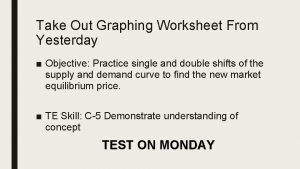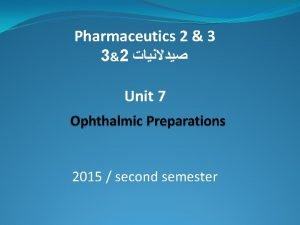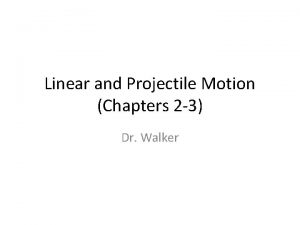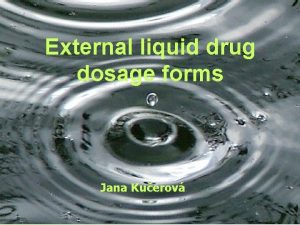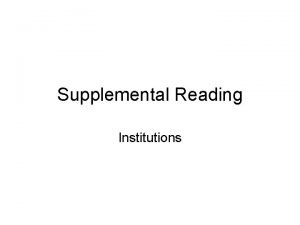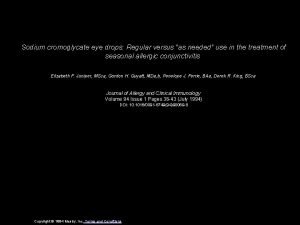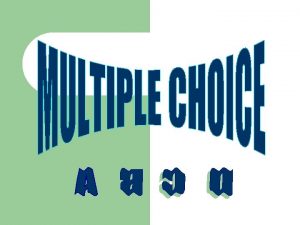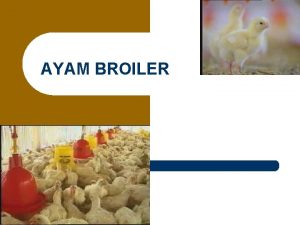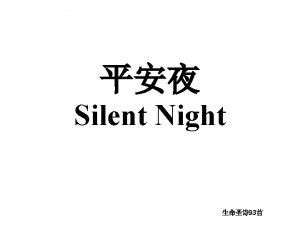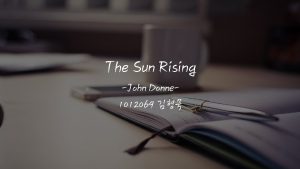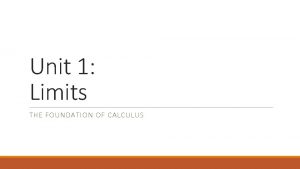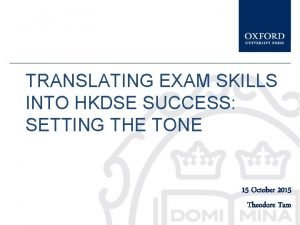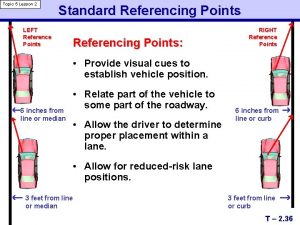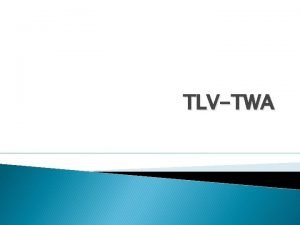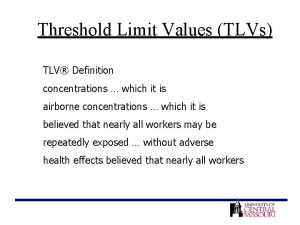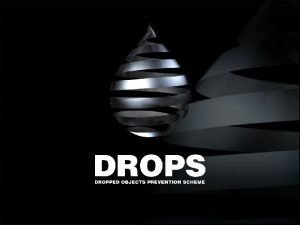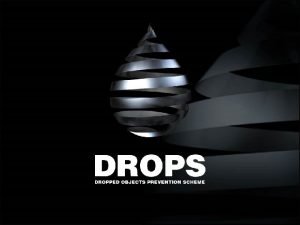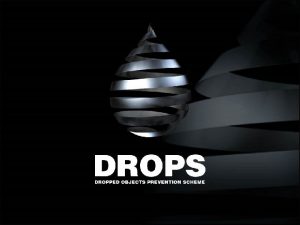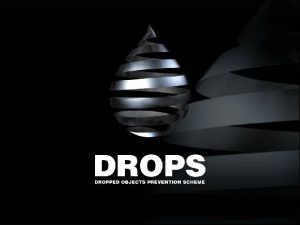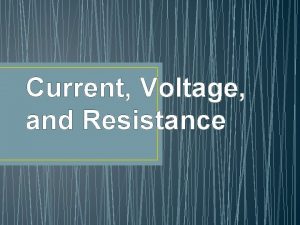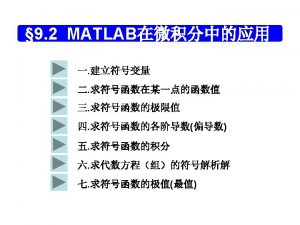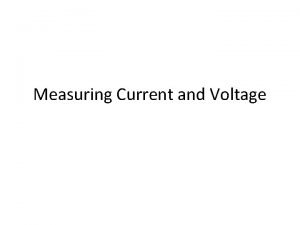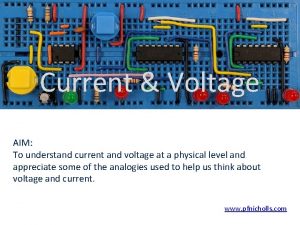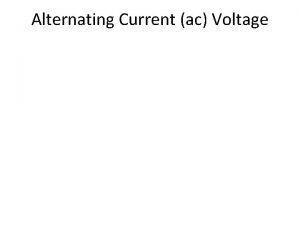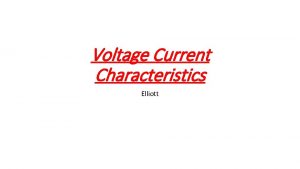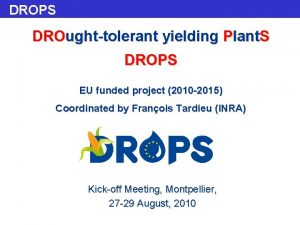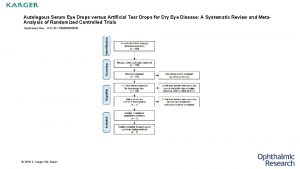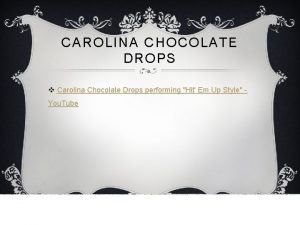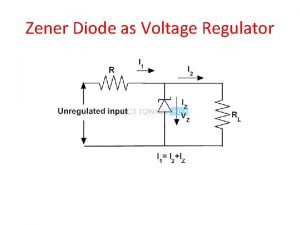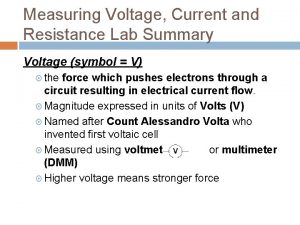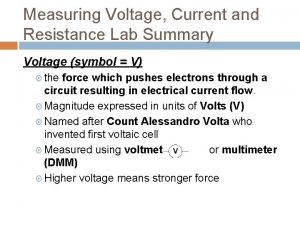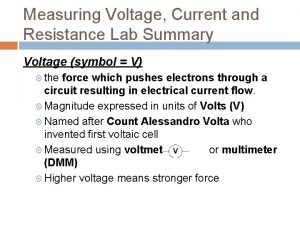RESISTORS Resistors limit current create voltage drops All























































































































- Slides: 119

RESISTORS § § Resistors limit current, create voltage drops All resistors are rated in both a fixed ohm value of resistance and a power rating in watts. (Watt = Volts X Amps) § Unit -- Ohm Ώ resistor in series with an LED Enough current flows to make the LED light up, But not so much that the LED is damaged

TYPES 1. Fixed Resistor 2. Variable Resistor Fixed Resistor Electric symbol Generic Variable Resistor Electrical Symbol

FIXED RESISTORS • Fixed-value resistors are divided into two category types of resistors: Carbon / Metal Oxide and Wire-Wound. Carbon and Metal Oxide flm Wire wound

CARBON RESISTORS • • Carbon resistors are commonly used in electronic systems. Carbon is mixed with binder; the more carbon, the lower the resistance. Carbon resistors have a fixed resistance value and are used to limit current flow. • They are rated in watts and most have color-code bands to show the resistance value. • A typical resistor has a watt rating from 0. 125 W to 2. 0 W. Carbon Metal Oxide film

WIRE-WOUND RESISTORS • Made with coils of resistance wire. • Often enclosed in ceramic to help dissipate heat and protect the resistor wire, • Accurate and heat stable. • The resistance value is often marked. • Used in higher watt circuits often 2 W or higher. • An ignition ballast resistor is an example of a wire wound resistor.

VARIABLE RESISTORS • Resistance increases with increasing length. It is possible to use this effect to build a variable resistor. • Resistance can be altered by changing the length of resistor in the circuit. The device below allows just that: Rotating the knob alters the length, and in turn the resistance. Types • Rheostat • Potentiometer • Trimmer

RHEOSTAT • Rheostats have two connections, • one to the fixed end of a resistor and the other to a sliding contact on the resistor. • Turning the control moves the sliding contact away from or toward the fixed end, increasing or decreasing the resistance. • Rheostats control resistance, thus controlling current flow.

RHEOSTAT OPERATION • As the wiper moves along the rheostat it exposes more or less of the resistor. Moving the wiper towards the high places a small portion of the resistor in series with the light, causing the light to glow bright. Moving the wiper toward the low, places a larger portion of the resistor in series with the lamp; this increased resistance causes less current to flow lowering the intensity of the light. Rheostats are not used on computer circuits because of temperature variations on the resistor when the wiper arm is moved.

POTENTIOMETER • • • Used to measure changes in position. Have three connections or legs: the reference, signal, and ground. The reference is at one end of a resistor and the Ground is at the other end. Current flows from the Reference through the resistor to Ground creating a voltage drop across the resistor. The Signal is a sliding contact (movable wiper arm) that runs across the resistor. Unlike a rheostat, its main purpose is not to vary resistance but to vary the voltage in a circuit Potentiometer Symbol . Variable Resistor Symbol

POTENTIOMETER OPERATION • Remember a potentiometer has three legs, the reference (R), the signal (S) , and the ground (G) as shown below. 5 volts is supplied to the reference, current flows from the reference (R) through the entire resistor to ground (G). The Signal wiper slides across the resistor changing measure voltage as it moves. As the wiper moves towards the reference (R), the measured signal voltage at (S) will increase. As the wiper moves away from the Reference (R) towards ground (G), the measured signal voltage drops

POTENTIOMETER APPLICATIONS • Since potentiometer are used to measure changes in position they naturally are used for throttle, EGR, AC blend door, and power seat position sensors. All potentiometers have three wires and are used to measure position changes

RESISTOR RATING COLOR BANDS • The first two bands set the digit or number value of the resistor. • The third band, also known as the multiplier band, is the number of zeros added to the number value. • The last band is the Tolerance band. Example: +/- 10%

RESISTOR COLOR BAND CHART • The chart below is used to interpret the color bands on the carbon resistor. Another chart is used to show the value of tolerance band colors

READING COLOR BANDS RATING VALUE • The first color band is Green with a value of "5". The second color band is Red with a value of "2". The third band is Black with a value of "0" zero. (No zeros are added) • So the resistor has a base value of 52 ohms.

READING COLOR BANDS TOLERANCE VALUE • Resistors vary in tolerance (accuracy). Common tolerance values are 20%, 10%, 5%, 2%, or 1%, simply meaning the maximum percent allowable difference the resistor value actually is from the designed value rating. A 1% resistor is a higher quality resistor than one with a 20% rating. • The tolerance band (last band) is silver with a value of 10%. So, the resistance value is "52 ohms plus or minus 5. 2 ohms" (46. 8 to 57. 2 ohms).

CAPACITOR • A device used to store charge in an electrical circuit • functions much like a battery but charges and discharges much more efficiently • A basic capacitor is made up of two conductors separated by an insulator, or dielectric • The dielectric can be made of paper, plastic, mica, ceramic, glass, a vacuum or nearly any other nonconductive material Symbol of capacitor

CAPACITANCE • • • Measure of a capacitor's ability to store charge. A large capacitance means that more charge can be stored Measured in farads, symbol F. However 1 F is very large, so prefixes are used to show the smaller values. Three prefixes (multipliers) are used, µ (micro), n (nano) and p (pico): • µ means 10 -6 (millionth), so 1000000µF = 1 F • n means 10 -9 (thousand-millionth), so 1000 n. F = 1µF • p means 10 -12 (million-millionth), so 1000 p. F = 1 n. F

TYPES • Fixed capacitors • Electrolytic capacitors – Polarized capacitors – Nonpolarized capacitors » Ceramic capacitors » Plastic capacitors » Mica capacitors » Paper capacitors • Variable capacitors

FIXED CAPACITORS Electrolytic capacitors Polarized capacitor • have implicit polarity • can only be connected one way in a circuit • Symbol Nonpolarized capacitor • • • has no implicit polarity can be connected either way in a circuit. Eg Ceramic, mica

VARIABLE CAPACITORS • • Mostly used in radio tuning circuits Sometimes called “ tuning capacitors” Have very small capacitance values Ttypically between 100 p. F and 500 p. F (100 p. F = 0. 0001µF) Variable Capacitor Symbol

DISSIPATION FACTOR • Measure of the power factor (or losses) of a capacitor • DF = 2 P f. RC X 100%, where • • • R -- Equivalent Series Resistance (ESR) of the capacitor, f -- frequency, C -- capacitance. Dissipation factor varies with frequency and temperature. ESR -- measure of the total lossiness of a capacitor which includes the leads, electrodes, dielectric losses, leakage (IR) and most important, the end spray connecting the leads to the metallized film.

Inductors Inductor are used in electrical circuits because they store energy in their magnetic fields. What is an Inductor? Current Flux i A coil of wire that can carry current Current produces a magnetic field Energy is stored in the inductor

TYPES • Fixed inductors – Depending on the type of core used • Air core inductors • Iron core inductors • Ferrite core inductors • Variable inductors

FIXED INDUCTORS • Air core inductors • Consists of few turns of wire, wound on a hollow former • Generally used in radio frequency applications where very low value of inductance is required • Iron core inductors • Contains a number of turns of copper wire, wound on a hollow former • Generally used in low frequency applications such as filter circuits in power supplies or chokes in fluorescent tubes

FIXED INDUCTORS (contd…) • Ferrite core inductors • Made up of non-metallic compounds consisting mainly of ferric oxide in combination with one or two bivalent metal oxides • Appliocations » r. f. chokes for supply decoupling purpose » Switching regulated type dc power supplies » Various types of filters used in communication equipment

VARIABLE INDUCTORS • symbol • Hollow former has screw threads in the inner hollow portion • Similar matching threads are provided on the ferrite core which can be screwed in or out of the former • Because of the change of the position of the ferrite core, the value of the inductance changes • Maximum when ferrite core is fully in

Q of an Inductor • No power loss in an ideal inductor • But losses do occur in practicalinductor • 2 types of losses • Hysteresis and eddy current losses in the core • I 2 R loss Rs Ls Equivalent circuit of an Inductor Q = ω Ls / R s

THE BIPOLAR JUNCTION TRANSISTOR • The bipolar junction transistor is a 3 -terminal device consisting 2 layers of n-type material sandwiching a thin p-type layer or 2 layers of p-type material sandwiching a thin layer of n-type material. • These structures are appropriately called npn transistor and pnp transistor, respectively. • The terminals are called Emitter, Base and Collector. • The emitter is heavily doped, the base is lightly doped and collector is moderately doped.

TRANSISTOR PHYSICAL STRUCTURE AND SYMBOL

• There are two types of BJTs, the npn and pnp • The two junctions are termed the base-emitter junction and the base-collector junction • The term bipolar refers to the use of both holes and electrons as charge carriers in the transistor structure • In order for the transistor to operate properly, the two junctions must have the correct dc bias voltages – the base-emitter (BE) junction is forward biased – the base-collector (BC) junction is reverse biased Forward-Reverse bias of a BJT

TRANSISTOR OPERATION For current to flow through the BJT its two p-n junctions (2 diodes back to back) must be properly biased. Typically, one junction is forward bias while the other is reverse bias. The figure below shows the biasing of a pnp transistor Notice that the emitter-base junction is forward biased while the collector-base junction is reverse biased. Majority carriers will flow from emitter to base across the forward biased junction. Because the base layer is very thin and has a high resistance (lightly doped) most of these carriers will diffuse across the reverse-biased junction into the collector in the same direction of the minority charges, and only tiny amounts of current will flow out of the base terminal. Typically collector currents are of the order of m. A while base currents are μA. Appling Kirchhoff’s current law: IE = IC + IB

TRANSISTOR CURRENTS • Transistor Currents: IE = I C + I B • alpha (αDC) IC = αDCIE • beta (βDC) IC = βDCIB – βDC typically has a value between 50 and 500

TRANSISTOR VOLTAGES • DC voltages for the biased transistor: • Collector voltage VC = VCC - ICRC • Base voltage VB = VE + VBE – for silicon transistors, VBE = 0. 7 V BJT operating modes

OPERATION MODE

OPERATION MODE • Active: – Most importance mode, e. g. for amplifier operation. – The region where current curves are practically flat. • Saturation: – Barrier potential of the junctions cancel each other out causing a virtual short. – Ideal transistor behaves like a closed switch. • Cutoff: – Current reduced to zero – Ideal transistor behaves like an open switch.

BJT - operation in Active mode Active Mode Circuit Model



TRANSISTOR CONFIGURATIONS There are three types: Common-Base (CB), Common-Emitter (CE), and Common. Collector (CC). THE COMMON-BASE CONFIGURATION The base is common to both the input and the output, usually at ground potential. Features of CB Connection • Current Gain <1 • Power Gain>1 • Voltage Gain>1 • Low i/p Impedance • High o/p Impedance

THE COMMON-EMITTER CONFIGURATION • Emitter is common or reference to both input and output signal. • The CE configuration is the one most commonly encountered since it provides both good current and voltage gain for ac signals. • In the CE configuration the input is between the base and the emitter. The output is between the collector and the emitter.

THE COMMON-COLLECTOR CONFIGURATION OR EMITTER FOLLOWER • Collector is common to both input and output. Mainly used for current amplification and impedance matching. • Characteristics curve is same as CE configuration • A typical transistor power amp will have a CE stage followed by a CC stage Features of CC Connection • High Input Impedance • Low Output impedance • Voltage Gain < 1 • Power + Current Gain

SOME CHARACTERISTICS OF BJTS – A RECAP 1. An equivalent circuit of a NPN transistor is two diodes tied anode to anode; one cathode being the emitter, the other the collector, and the junction of the anodes is the base. 2. When a NPN transistor is in operation, there is always a constant 0. 6 volt drop between the base and emitter, i. e. , the base is always ~ 0. 6 volts more positive than the emitter--always! 3. There is no output at the collector, until the base has reached ~ 0. 6 volts and the base is drawing current, i. e. , any signal that appears at the base that is not up to ~ 0. 6 volts (and not drawing base current), is never seen at the collector. 4. The base requires a current, not a voltage to control the collector current. 5. The collector is a current source: it does not source a voltage. 6. The collector appears to output a voltage when a resistor is connected between it and power. 7. The collector is a high impedance when compared to the emitter.

SOME CHARACTERISTICS OF BJTS – A RECAP 8. The transistor can output an amplified signal either from the collector or the emitter (or both). 9. When operating with a collector resistor (RL): the output voltage from the collector is an amplified voltage. 10. When operating with only an emitter resistor (Re): the output voltage from the emitter is not an amplified voltage, because it is always ~ 0. 6 volts, below the input (base) voltage--hence the name voltage follower. But because the emitter can source large amounts of current to the "LOAD, " it can be said, there was CURRENT amplification. 11. The collector--being high impedance--cannot drive a low impedance load. 12. The emitter--being a low impedance--can drive a low impedance load. 13. The voltage gain from the collector is greater than one (Gv > 1). 14. The voltage gain from the emitter is less than one (Gv < 1). 15. Both the collector and the emitter: output ~ the same power: E x I = P.

Silicon Controlled Rectifiers

Silicon Controlled Rectifier • A Silicon Controlled Rectifier (or Semiconductor Controlled Rectifier) is a four layer solid state device that controls current flow • The name “silicon controlled rectifier” is a trade name for the type of THYRISTOR commercialized at General Electric in 1957

Silicon Controlled Rectifier • An SCR can be seen as a conventional rectifier controlled by a gate signal • It is a 4 -alternately doped semiconductor layers 3 -terminal device. 3 -leads are referred to as the Anode, Cathode, and Gate. • When the gate to cathode voltage exceeds a certain threshold, the device turns 'on' and conducts current • Which are used as electronically controlled switches

Silicon Controlled Rectifier • The operation of a SCR can be understood in terms of a pair of tightly coupled Bipolar Junction Transistors • used for the purpose of controlling electrical power while BJT's and FET's. Since they do not have the power handling capability • SCR has three states: • Reverse blocking mode, forward blocking mode, and forward conducting mode

TYPES OF DIODES

V-I Characteristics of SCR • The V-I curve shows the relationship between VF and IF when the SCR's gate is open. • When a Forward voltage is applied to the SCR, – The SCR's cathode-to-anode voltage is designated as VF at this time. VF increases from zero, the SCR conducts only a small forward current (IF ) which is due to leakage. As VF continues to increase, IF remains very low and almost constant but eventually a point is reached where IF increases rapidly and VF drops to a low value. – The VF value required to trigger this sudden change is referred to as the Forward Breakover Voltage (Vp). When this value of Vp is reached the SCR simply breaks down, and conducts a high IF which is limited only by the external resistance in series with the device. – The SCR switches from the off state to the on state at this time. The drop in VF occurs because the SCR' s resistance drops to an extremely low value and most of the source voltage appears across the series resistor.

• When the SCR is in the on state, – only a slight increase in VF is required to produce a tremendous increase in IF. – the SCR will remain in the on state as long as IF remains at a substantial value. Only when IF drops below a certain minimum value, will the SCR switch back to its off-state. – This minimum value of IF which will hold the SCR in the on state is referred to as the SCR's Holding Current and is usually designated at IH. The IH value is located at the point where breakover occurs.

• When a reverse voltage is applied to the SCR, – the device functions in basically the same manner as a reverse-biased PN junction diode. As the reverse voltage, – (VR ) across the SCR increases from zero, only a small reverse current (IR) will flow through the device due to leakage. This current will remain small until VR becomes large enough to cause the SCR to breakdown. Then IR will increase rapidly if VR increases even slightly above the breakdown point. – The reverse voltage (VR) required to breakdown the SCR is referred to as the SCR's Reverse Breakdown Voltage. – – If too much reverse current is allowed to flow through the SCR after breakdown occurs, the device could be permanently damaged. – this situation is normally avoided because the SCR is usually subjected to operating voltages which are well below its breakdown rating.

• When the gate is made positive with respect to the cathode, – gate current will flow and the SCR's forward characteristics will be affected. – The Ig = 0 curve shows the relationship between VF and IF when the gate current is zero. – The Ig 1 curve is plotted for a specific but relatively low value of gate current. Notice that this curve has the same general shape as the Ig = 0 curve but the forward breakover point occurs sooner (at a lower VF value). – The Ig 2 curve is plotted for a slightly higher gate current and also has the same general shape as the other two curves. However, the breakover point occurs even sooner at this higher for different values of gate value of gate current.


Silicon Controlled Rectifier • Industrially SCRs are applied to produce DC voltages for motors from AC line voltage • Rectifier – Half-wave rectifier, full-wave rectifier

Half-wave rectifier

Half-wave rectifier

Half-wave rectifier

Reviews • A SCR is essentially a diode with an extra terminal added • This extra terminal is called the gate, and it is used to trigger the device into conduction by the application of a small voltage • Widely used in applications where dc and ac power must be controlled. These devices are often used to apply a specific amount of power to a load or to completely remove it however, they are also used to regulate or adjust the amount of power applied to a specific load.

Application: DC Motor Driver • DC motor speed generally depends on a combination of the voltage and current flowing in the motor coils and the motor loads or braking torque • The speed of the motor is proportional to the voltage, and the torque is proportional to the current

Light Emitting Diodes

• Light emitting diodes, commonly called LEDs, are real unsung heroes in the electronics world. • They form the numbers on digital clocks, transmit information from remote controls, light up watches and they can form images on a jumbo television screen 0 r illuminate traffic light. • Basically, LEDs are just tiny light bulbs that fit easily into an electrical circuit. But unlike ordinary incandescent bulbs, they don't have a filament that will burn out, and they don't get especially hot. They are illuminated solely by the movement of electrons in a semiconductor material, and they last just as long as a standard transistor.


Inside a LED • The two wires extending below the LED epoxy enclosure, or the "bulb" indicate how the LED should be connected into a circuit. • The negative side of an LED lead is indicated in two ways: – by the flat side of the bulb, – by the shorter of the two wires extending from the LED. – The negative lead should be connected to the negative terminal of a battery. LED's operate at relative low voltages between about 1 and 4 volts, and draw currents between about 10 and 40 milliamperes. – Voltages and currents substantially above these values can melt a LED chip. – The most important part of a LED is the semi-conductor chip located in the center of the bulb. – The chip has two regions separated by a junction. The p region is dominated by positive electric charges, and the n region is dominated by negative electric charges. – The junction acts as a barrier to the flow of electrons between the p and the n regions. Only when sufficient voltage is applied to the semi-conductor chip, can the current flow, and the electrons cross the junction into the p region. – In the absence of a large enough electric potential difference (voltage) across the LED leads, the junction presents an electric potential barrier to the flow of electrons.

LED-Electrical Properties-PN junctions

Operation • When the current flows across a diode the negative electrons move one way and positive holes move the other way. • the holes exist at a lower energy level than the free electrons, so when a free electron falls it loses energy • this energy emitted in the form of a light photon. The size of electron’s “fall” determines the energy level of the photon, which determines its colour. A bigger fall produces a photon with the higher energy level and therefore a higher light frequency.

(Contd…) • PN junction diode in forward bias, the electron-hole recombination leads to photon emission • I = Is(ee. V/k. T-1) • Threshold voltage Vth = Eg/e • I = Isee. V/ηk. T where η is the ideality factor Double Heterostructure is used to confine the carriers, improving the radiative recombination rate

LED-Optical Properties-Efficiency • ηint = # of photons emitted from active region per second # of electrons injected in to LED per second = Pint / (hν) I/e • ηextr = # of photons emitted into free space per second # of photons emitted from active region per second = P / (hν) Pint / (hν)

» Temperature dependence of emission intensity • Emission intensity decreases with increasing temperature. • Causes include non-radiative recombination via deep levels, surface recombination, and carrier loss over heterostucture barriers. » High internal efficiency LED designs • Radiative recombination probability needs to be increased and non-radiative recombination probability needs to be decreased. • High carrier concentration in the active region, achieved through double heterostructure (DH) design, improves radiative recombination. R=Bnp • DH design is used in all high efficiency designs today.

High internal efficiency designs • Doping of the active regions and that of the cladding regions strongly affects internal efficiency. • Active region should not be heavily doped, as it causes carrier spill-over in to the confinement regions decreasing the radiative efficiency • Doping levels of 1016 -low 1017 are used, or none at all. • P-type doping of the active region is normally done due to the larger electron diffusion length. • Carrier lifetime depends on the concentration of majority carriers. • In low excitation regime , the radiative carrier lifetime decreases with increasing free carrier concentration. • Hence efficiency increases with doping. • At high concentration, dopants induce defects acting as recombination centers.

High extraction efficiency structures • Shaping of the LED die is critical to improve their efficiency. • LEDs of various shapes; hemispherical dome, inverted cone, truncated cones etc have been demonstrated to have better extraction efficiency over conventional designs. • However cost increases with complexity.

Visible spectrum LEDs The plot charts the gains made in luminous efficiency till date.

White-light LEDs • White light can be generated in several different ways. • One way is to mix to complementary colors at a certain power ratio. • Another way is by the emission of three colors at certain wavelengths and power ratio. • Most white light emitters use an LED emitting at short wavelength and a wavelength converter. • The converter material absorbs some or all the light emitted by the LED and re-emits at a longer wavelength. • Two parameters that are important in the generation of white light are luminous efficiency and color rendering index. • It is shown that white light sources employing two monochromatic complementary colors result in highest possible luminous efficiency.

White-light LEDs( Contd…) • Wavelength converter materials include phosphors, semiconductors and dyes. • The parameters of interest are absorption wavelength, emission wavelength and quantum efficiency. • The overall energy efficiency is given by η = ηext(λ 1/ λ 2) • Even if the external quantum efficiency is 1, there is always an energy loss associated with conversion. • Common wavelength converters are phosphors, which consist of an inorganic host material doped with an optically active element. • The optically active dopant is a rare earth element, oxide or another compound. • Common rare earth elements used are Ce, Nd, Er and Th.

White-light LEDs • Phosphors are stable materials and can have quantum efficiencies of close to 100%. • Dyes also can have quantum efficiencies of close to 100%. • Dyes can be encapsulated in epoxy or in optically transparent polymers. • However, organic dyes have finite lifetime. They become optically inactive after 104 -106 optical transitions.

LED Advantages • While all diodes release light, most don't do it very effectively. • In an ordinary diode, the semiconductor material itself ends up absorbing a lot of the light energy. LEDs are specially constructed to release a large number of photons outward. • Additionally, they are housed in a plastic bulb that concentrates the light in a particular direction. • Most of the light from the diode bounces off the sides of the bulb, traveling on through the rounded end.

• Remote control operation (Advantages of LED) • the basic operation of the remote goes like this: You press a button. When you do that you complete a specific connection. The chip senses that connection and knows what button you pressed. It produces a morse-code-line signal specific to that button. The transistors amplify the signal and send them to the LED, which translates the signal into infrared light. The sensor in the TV can see the infrared light and "seeing" the signal reacts appropriately.

RECTIFIERS • INTRODUCTION • HALF WAVE RECTIFIERS • FULL WAVE RECTIFIERS • BRIDGE RECTIFIERS

• Rectification is the conversion of alternating current (AC) to direct current (DC). • A rectifier converts a sinusoidal voltage to a constant voltage. • This involves a device that only allows one-way flow of electrons. • As we have seen, this is exactly what a semiconductor diode does. • A Diode switches polarity from + to - many times a second, into a straight DC supply. • Rectifier is a type of ac-dc converter • �� Single phase • �� Three phase

HALF WAVE RECTIFIERS • A half-wave rectifier is a circuit that allows only one half-cycle of the AC voltage waveform to be applied to the load, resulting in one non-alternating polarity across it. • The resulting DC delivered to the load “pulsates” significantly. • This circuit takes an AC signal in and chops off anything that falls below 0 Volts. • The half-wave rectifier is used in AM radios to rectify the signal.

CIRCUIT DIAGRAM

OUTPUT WAVEFORM

WORKING PRINCIPLE OF THE HALF WAVE RECTIFIER

• The Half wave rectifier is a circuit, which converts an ac voltage to dc voltage. • In the Half wave rectifier circuit the transformer serves two purposes. • It can be used to obtain the desired level of dc voltage (using step up or step down transformers). • It provides isolation from the power line. • The primary of the transformer is connected to ac supply. • This induces an ac voltage across the secondary of the transformer.

• During the positive half cycle of the input voltage the polarity of the voltage across the secondary forward biases the diode. • As a result a current IL flows through the load resistor, RL. • The forward biased diode offers a very low resistance and hence the voltage drop across it is very small. • Thus the voltage appearing across the load is practically the same as the input voltage at every instant.

• During the negative half cycle of the input voltage the polarity of the secondary voltage gets reversed. • As a result, the diode is reverse biased. • Practically no current flows through the circuit and almost no voltage is developed across the resistor. • All input voltage appears across the diode itself.

• Thus when the input voltage is going through its positive half cycle, output voltage is almost the same as the input voltage and during the negative half cycle no voltage is available across the load. • This explains the unidirectional pulsating dc waveform obtained as output. • The process of removing one half the input signal to establish a dc level is aptly called half wave rectification. • The diode only conducts on every other half cycle. • There is one pulse for every cycle in. i. e 50 pulses per second (in the UK). • The rectified voltage is DC (it is always positive in value). However, it is not a steady DC but PULSATING DC. • It needs to be smoothed before it becomes useful. • If the diode is reversed then the output voltage is negative.

Signal In Signal Out (Half-wave):

The simplest rectifier uses one diode, like this:

PARAMETERS

Peak Inverse Voltage • When the input voltage reaches its maximum value Vm during the negative half cycle the voltage across the diode is also maximum. • This maximum voltage is known as the peak inverse voltage. • Thus for a half wave rectifier

Ripple Factor • Ripple factor is defined as the ratio of RMS value of ac component to the dc component in the output. • RMS voltage at the load resistance :

Efficiency • Efficiency, h is the ratio of the dc output power to ac input power:

Transformer Utilization Factor • Transformer Utilization Factor, TUF can be used to determine the rating of a transformer secondary. • In half wave rectifier the rated voltage of the transformer secondary is

• But actually the RMS current flowing through the winding is only

Form Factor • Form factor is given by,

Peak Factor • Peak factor is given by,

FULL WAVE RECTIFIERS • A full-wave rectifier is a circuit that converts both half-cycles of the AC voltage waveform to an unbroken series of voltage pulses of the same polarity. • The resulting DC delivered to the load doesn't “pulsate” as much. • A full-wave rectifier flips the negative half of the signal up into the positive range. • When used in a power supply, the full-wave rectifier allows us to convert almost all the incoming AC power to DC.

CIRCUIT DIAGRAM OF A FULL WAVE RECTIFIER


OUTPUT WAVEFORM

WORKING PRINCIPLE OF A FULL WAVE RECTIFIER

• • A Full Wave Rectifier is a circuit, which converts an ac voltage into a pulsating dc voltage using both half cycles of the applied ac voltage. It uses two diodes of which one conducts during one half cycle while the other conducts during the other half cycle of the applied ac voltage. During the positive half cycle of the input voltage, diode D 1 becomes forward biased and D 2 becomes reverse biased. Hence D 1 conducts and D 2 remains OFF. The load current flows through D 1 and the voltage drop across RL will be equal to the input voltage. During the negative half cycle of the input voltage, diode D 1 becomes reverse biased and D 2 becomes forward biased. Hence D 1 remains OFF and D 2 conducts. The load current flows through D 2 and the voltage drop across RL will be equal to the input voltage.

CURRENT FLOW DURING ONE HALF CYCLE

PARAMETERS

Ripple Factor The ripple factor for a Full Wave Rectifier is given by

RMS value of the voltage at the load resistance is

Efficiency • Efficiency, h is the ratio of the dc output power to ac input power • The maximum efficiency of a Full Wave Rectifier is 81. 2%.

Transformer Utilization Factor • Transformer Utilization Factor, TUF can be used to determine the rating of a transformer secondary. • It is determined by considering the primary and the secondary winding separately and it gives a value of 0. 693.

Form Factor • Form factor is defined as the ratio of the rms value of the output voltage to the average value of the output voltage.

Peak Factor • Peak factor is defined as the ratio of the peak value of the output voltage to the RMS value of the output voltage. • Peak inverse voltage for Full Wave Rectifier is 2 Vm because the entire secondary voltage appears across the non-conducting diode.

BRIDGE RECTIFIERS • The Bridge rectifier is a circuit, which converts an ac voltage to dc voltage using both half cycles of the input ac voltage. • A bridge rectifier can be made using four individual diodes. • It is called a full-wave rectifier because it uses all the AC wave (both positive and negative sections). • 1. 4 V is used up in the bridge rectifier because each diode uses 0. 7 V when conducting and there always two diodes conducting. • Bridge rectifiers are rated by the maximum current they can pass and the maximum reverse voltage they can withstand (this must be at least three times the supply RMS voltage so the rectifier can withstand the peak voltages). • One advantage of a bridge rectifier over a conventional full-wave rectifier is that with a given transformer the bridge rectifier produces a

CIRCUIT FOR A BRIDGE RECTIFIER Alternate pairs of diodes conduct, changing over the connections so the alternating directions of AC are converted to the one direction of DC.

OUTPUT OF A BRIDGE RECTIFIER Output: full-wave varying DC (using all the AC wave)

WORKING PRINCIPLE • • • The circuit has four diodes connected to form a bridge. The ac input voltage is applied to the diagonally opposite ends of the bridge. The load resistance is connected between the other two ends of the bridge. For the positive half cycle of the input ac voltage, diodes D 1 and D 3 conduct, whereas diodes D 2 and D 4 remain in the OFF state. The conducting diodes will be in series with the load resistance RL and hence the load current flows through RL.

• For the negative half cycle of the input ac voltage, diodes D 2 and D 4 conduct whereas, D 1 and D 3 remain OFF. • The conducting diodes D 2 and D 4 will be in series with the load resistance RL and hence the current flows through RL in the same direction as in the previous half cycle. • Thus a bi-directional wave is converted into a unidirectional wave.

PARAMETERS

Peak Inverse Voltage • Peak inverse voltage represents the maximum voltage that the non- conducting diode must withstand. • At the instance the secondary voltage reaches its positive peak value, Vm the diodes D 1 and D 3 are conducting, where as D 2 and D 4 are reverse biased and are non-conducting. • The conducting diodes D 1 and D 3 have almost zero resistance. • Thus the entire voltage Vm appears across the load resistor RL. The reverse voltage across the non-conducting diodes D 2 (D 4) is also Vm. • Thus for a Bridge rectifier the peak inverse voltage

Ripple Factor • The ripple factor for a Bridge Rectifier is given by • RMS value of the voltage at the load resistance is

Efficiency • Efficiency, h is the ratio of the dc output power to ac input power. • The maximum efficiency of a Bridge Rectifier is 81. 2%.
 If lclp is negative number, we set the lclp = 0. why?
If lclp is negative number, we set the lclp = 0. why? Limites de control
Limites de control Coba gambarkan
Coba gambarkan Medium voltage range
Medium voltage range Single phase ac voltage controller using triac
Single phase ac voltage controller using triac Line current and phase current
Line current and phase current Convert rms to peak voltage
Convert rms to peak voltage Explain the objective of earthing
Explain the objective of earthing Jika noel(create(q)) adalah 0 maka front(create(q)) adalah
Jika noel(create(q)) adalah 0 maka front(create(q)) adalah Mig welding voltage and current chart
Mig welding voltage and current chart Energy with voltage and current
Energy with voltage and current Source conversion
Source conversion Series vs parallel
Series vs parallel Current and voltage distribution in antenna
Current and voltage distribution in antenna Current and voltage distribution in antenna
Current and voltage distribution in antenna Current voltage graphs
Current voltage graphs Difference between power and voltage amplifier
Difference between power and voltage amplifier How to find the total current in a parallel circuit
How to find the total current in a parallel circuit Generation of high voltage
Generation of high voltage Lesson 6 current voltage and resistance in a circuit
Lesson 6 current voltage and resistance in a circuit Ohms triangle
Ohms triangle Types of telemetry
Types of telemetry Name all the lines name all the segments name all the rays
Name all the lines name all the segments name all the rays A balanced delta connected load having an impedance 20-j15
A balanced delta connected load having an impedance 20-j15 Energy band diagram of pnp transistor
Energy band diagram of pnp transistor Line current and phase current
Line current and phase current Drift current and diffusion current
Drift current and diffusion current What is diffusion current and drift current
What is diffusion current and drift current A jfet always operates with
A jfet always operates with Wye connection
Wye connection Infineon
Infineon Drift current and diffusion current in semiconductor
Drift current and diffusion current in semiconductor In alternators the welding current is produced on the ____.
In alternators the welding current is produced on the ____. Hazard based safety engineering
Hazard based safety engineering Mesh current method with current source
Mesh current method with current source Simplifying circuits
Simplifying circuits Identical resistors
Identical resistors Resistors in series and parallel
Resistors in series and parallel A package contains 12 resistors 3 of which are defective
A package contains 12 resistors 3 of which are defective Resistors in series and parallel equations
Resistors in series and parallel equations Kmart breadboard
Kmart breadboard Two cylindrical resistors are made from the same material
Two cylindrical resistors are made from the same material The power process: “i create it all” is:
The power process: “i create it all” is: Examples of non material culture
Examples of non material culture Fortified eye drops
Fortified eye drops Instilling ear drops in child
Instilling ear drops in child Little drops of water little grains of sand
Little drops of water little grains of sand Keva triple stem cell benefits
Keva triple stem cell benefits Keva eye care drops uses
Keva eye care drops uses Drop factor formula with example
Drop factor formula with example Gtts per min
Gtts per min Fishbone organizer
Fishbone organizer Gtts per min
Gtts per min A 16 kg canoe moving to the right at 12 m/s
A 16 kg canoe moving to the right at 12 m/s Iv fluid rate calculation
Iv fluid rate calculation Blood spatter from different heights
Blood spatter from different heights Drops oil and gas
Drops oil and gas When administering ear drops to adults the pinna is pulled
When administering ear drops to adults the pinna is pulled Luke autbeloe drops an approximately
Luke autbeloe drops an approximately Example of collision
Example of collision Keva solar energy drops
Keva solar energy drops Keva kamd demo
Keva kamd demo Three main cloud types
Three main cloud types Aunt minnie drops a penny
Aunt minnie drops a penny Ctmd
Ctmd Paraphrase in a sentence
Paraphrase in a sentence Otodex ear drops for dogs side effects
Otodex ear drops for dogs side effects Penny lab conclusion
Penny lab conclusion Goniosol
Goniosol Elery
Elery The darkness drops again but now i know
The darkness drops again but now i know Christopher marlowe shakespeare
Christopher marlowe shakespeare Smart eye drops
Smart eye drops Tca accelerator drops directions
Tca accelerator drops directions The monophasic liquid are prepared with which solvent
The monophasic liquid are prepared with which solvent Prince rupert's drops
Prince rupert's drops Water drops
Water drops Luke drops a pile of roof shingles
Luke drops a pile of roof shingles Ringworm cream boots
Ringworm cream boots Carbodrates
Carbodrates A hopper drops gravel at a rate of 75 kg
A hopper drops gravel at a rate of 75 kg Quadrant method hydrology
Quadrant method hydrology Rizol gamma
Rizol gamma Insects kill half the world's tomato crop
Insects kill half the world's tomato crop Luke autbeloe drops an approximately
Luke autbeloe drops an approximately Formulation of eye drops
Formulation of eye drops Fov tears
Fov tears Z-track method
Z-track method Luke drops a pile of roof shingles
Luke drops a pile of roof shingles Hydrogenii peroxidi 3
Hydrogenii peroxidi 3 Carprofen drops
Carprofen drops When installing tabletop equipment on legs
When installing tabletop equipment on legs Water drops pierce stone
Water drops pierce stone Sodium cromoglycate eye drops
Sodium cromoglycate eye drops Keva thyroid care
Keva thyroid care Franchisebatao
Franchisebatao Keva eyeliner
Keva eyeliner Aerodispersions
Aerodispersions Geotech
Geotech What is old susy’s place?
What is old susy’s place? Love all serve all
Love all serve all Interventi sociali rivolti all'infanzia e all'adolescenza
Interventi sociali rivolti all'infanzia e all'adolescenza Above all powers above all kings
Above all powers above all kings I work all day i work all night to pay the bills
I work all day i work all night to pay the bills Basic communication operations in parallel computing
Basic communication operations in parallel computing Sistem all in all out
Sistem all in all out Mesothenar
Mesothenar Silent night holy night all is calm
Silent night holy night all is calm You are my all in all images
You are my all in all images All of you is more than enough for all of me
All of you is more than enough for all of me She's all states and all princes i
She's all states and all princes i No guilt in life no fear in death
No guilt in life no fear in death Above all powers above all kings
Above all powers above all kings Safe operating limit
Safe operating limit Special trig limits
Special trig limits Dse english writing text types
Dse english writing text types What is a standard reference point
What is a standard reference point Cat bkn
Cat bkn Value definition
Value definition Threshold limit
Threshold limit











